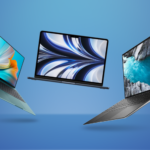The television landscape in 2025 is more exciting than ever, with advancements in display technology, smart features, and gaming capabilities pushing the boundaries of home entertainment. Whether you’re a cinephile craving cinematic visuals, a gamer chasing lag-free performance, or a budget-conscious shopper seeking value, choosing the right TV can transform your viewing experience. In this guide, we’ve scoured the market to bring you the best TVs for 2025, offering detailed reviews, expert insights, and practical advice to help you find the perfect set.
This isn’t just a list—it’s a deep dive into what makes these TVs stand out, from their jaw-dropping picture quality to their innovative designs. We’ll explore the latest trends in TV tech, break down key buying considerations, and provide a comparison table and FAQs to answer all your burning questions. Let’s get started!
How to Choose the Right TV: A Buyer’s Blueprint
Picking a TV involves more than just eyeing the price tag or screen size. Here’s a detailed breakdown of the factors you need to consider to match a TV to your lifestyle and space.
Screen Size: Finding the Sweet Spot
Screen size is the first hurdle. Too small, and you’re squinting; too large, and it overwhelms your room. The golden rule? Multiply your viewing distance (in inches) by 0.84. Sitting 8 feet (96 inches) away? A 75- to 80-inch TV is ideal. But don’t stop there—factor in room layout, furniture placement, and personal preference. Larger screens amplify immersion for movies and games, while smaller ones suit cozy spaces like bedrooms. For more guidance, check out RTINGS.com’s screen size calculator.
- Pro Tip: Measure your wall or stand space and account for bezels. A 65-inch TV might fit physically but feel cramped if it’s too close to your couch.
Resolution: 4K, 8K, or Bust?
Resolution dictates detail. In 2025, 4K (3840 x 2160) remains the sweet spot for most, delivering crisp images on screens up to 85 inches. Native 4K content is widely available on streaming platforms like Netflix and Disney+, making it a practical choice.
8K (7680 x 4320) is the bleeding edge, offering four times the pixels of 4K. It shines on massive screens (75 inches and up) or if you sit close, but native 8K content is scarce. Upscaling tech helps, but unless you’re future-proofing or splurging, 4K is still king. Learn more about 8K’s current state at CNET.
- Consider This: At typical viewing distances (6-10 feet), 8K’s benefits are subtle on screens under 75 inches. Stick to 4K unless you’re going big.
Panel Types: OLED, QLED, Mini-LED, and More
The panel is the heart of your TV’s picture quality. Here’s the rundown:
- OLED: Self-emissive pixels deliver perfect blacks, infinite contrast, and wide viewing angles. Ideal for dark rooms and movie lovers, but brightness tops out lower than rivals, and burn-in is a rare risk with static images (think news tickers). See LG’s OLED technology page for details.
- QLED: Quantum dots boost color and brightness in LED-backlit screens. Great for bright rooms and HDR, though black levels and contrast lag behind OLED. Explore Samsung’s QLED lineup.
- Mini-LED: An evolution of LED, using tiny LEDs for finer local dimming zones. It bridges the gap between OLED’s contrast and QLED’s brightness. Check out TCL’s Mini-LED explanation.
- Standard LED: Budget-friendly but lacks the punch of premium panels. Fine for casual viewing.
- Best For: OLED for cinephiles, QLED/Mini-LED for versatility, LED for tight budgets.
Refresh Rate: Smoothness Matters
Refresh rate (measured in Hz) determines how often the screen updates. 60Hz is standard for movies and TV, but 120Hz or higher is a game-changer for sports, action films, and gaming. Paired with Variable Refresh Rate (VRR) and Auto Low Latency Mode (ALLM), it’s a must for PlayStation 5 or Xbox Series X owners.
- Gamer Alert: Look for 120Hz with HDMI 2.1 for 4K gaming at high frame rates. IGN’s gaming TV guide has more.
HDR: Bringing Colors to Life
High Dynamic Range (HDR) enhances contrast and color depth. Key formats include:
- HDR10: Common and static, good baseline.
- Dolby Vision: Dynamic metadata for scene-by-scene optimization—superior if supported. See Dolby’s official page.
- HDR10+: Samsung’s answer to Dolby Vision, less widespread. Learn more at HDR10+ Technologies.
- HLG: For broadcast TV.
- Check Compatibility: Ensure your TV and content (e.g., Blu-rays, streaming apps) align on HDR formats.
Smart Features: Your Digital Hub
Smart TVs are mini-computers. Platforms like LG’s webOS, Samsung’s Tizen, and Google TV offer app ecosystems, voice control, and smart home integration. Prioritize usability, app availability (Netflix, Hulu, etc.), and voice assistants (Alexa, Google Assistant).
- Standout Feature: Look for AirPlay 2 or Chromecast for seamless phone-to-TV casting.
Connectivity: Ports and Beyond
Count your devices—consoles, soundbars, streaming sticks—and match them to HDMI ports. HDMI 2.1 supports 4K/120Hz and eARC for premium audio. USB, Ethernet, and Wi-Fi (preferably Wi-Fi 6) round out the package. HDMI.org explains HDMI 2.1 in detail.
- Future-Proofing: Extra ports prevent upgrade headaches.
Sound: Built-In or Add-On?
TV speakers have improved, but they rarely match a soundbar or surround system. Check for Dolby Atmos support and wattage, but plan to budget for audio upgrades if immersion is key. Sound & Vision covers Atmos basics.
Latest Trends in TV Technology for 2025
TVs in 2025 are smarter, sharper, and more versatile. Here’s what’s driving the market:
8K Takes Center Stage
8K TVs are dropping in price, with brands like Samsung and TCL leading the charge. AI upscaling makes 4K and HD content look stunning, though native 8K remains niche. It’s a luxury pick for early adopters. TechRadar tracks 8K’s rise.
Mini-LED Matures
Mini-LED refines LED tech confirming thousands of dimming zones, rivaling OLED’s contrast while hitting higher brightness (up to 2000 nits). TCL’s QM8 and Hisense’s U8N showcase its potential.
Gaming Gets Serious
120Hz panels, VRR, ALLM, and HDMI 2.1 are standard on premium sets. Sony’s “Perfect for PS5” TVs and LG’s OLEDs cater to gamers with sub-1ms input lag and G-Sync/FreeSync compatibility.
AI Everywhere
AI upscaling sharpens old content, while voice assistants and smart home integration (e.g., Matter protocol) make TVs central hubs. Samsung’s AI Motion Enhancer smooths fast action flawlessly.
Eco-Friendly Designs
Energy-efficient panels and recyclable packaging are trending, with LG and Sony touting sustainability credentials. Energy Star highlights eco-friendly TVs.
Top TVs for 2025: Our Picks
We’ve tested and researched to bring you the cream of the crop across budgets. Here’s the lineup:
Budget-Friendly
- Hisense U6N: Best value pick with surprising punch.
Mid-Range
- LG C3 Evo: OLED excellence at a reasonable price.
- Samsung S90C: QLED vibrancy with gaming chops.
High-End
- LG Evo G4: The OLED pinnacle.
- Samsung S95D: QLED’s brightest star.
Honorable Mentions
- Sony A95K: Color mastery in OLED form.
- TCL QM8: Mini-LED on a budget.
- Panasonic Z95A: Audio-visual bliss.
New Additions for 2025
- Sony Bravia 9: Mini-LED marvel.
- TCL C855: Affordable 8K option.
- Philips OLED+908: Ambilight ambiance.
- Vizio Quantum X: Budget QLED contender.
- Sharp Aquos XLED: Hybrid display innovation.
In-Depth Reviews
Hisense U6N: The Budget Champion
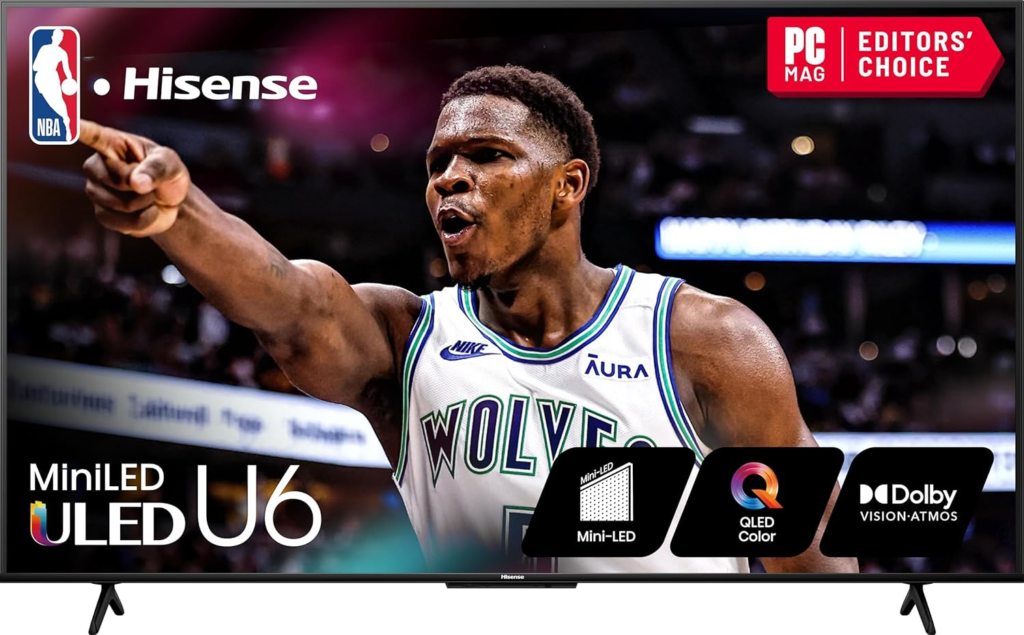
- Sizes: 50″, 55″, 65″, 75″, 85″
- Panel: QLED with Full-Array Local Dimming
- Latest Update: 2025 model introduces improved AI upscaling and a sleeker design. See Hisense’s official page.
Design
The U6N sports a minimalist look with slim bezels and a robust central stand. Its matte black finish blends into any decor, and the larger sizes (75″ and 85″) make a statement without breaking the bank. The 2025 model features a thinner profile and a cable management system for a cleaner setup.
Picture Quality
For the price, the U6N’s 4K QLED panel is a stunner. Quantum dots deliver rich, accurate colors—think vivid reds and deep blues—while full-array local dimming boosts contrast to near-OLED levels in dim scenes. Peak brightness hits around 600 nits, solid for SDR and entry-level HDR (HDR10, Dolby Vision). The 2025 update includes improved AI upscaling, making 1080p content look sharper than ever.
Sound Quality
The 20W speakers are serviceable—dialogue is clear, but bass is weak. Action movies feel flat without a soundbar. Dolby Atmos passthrough via eARC is a plus for external audio setups. The 2025 model adds virtual surround sound for a more immersive experience.
Smart Features
Google TV powers the U6N, offering a slick interface and vast app library. Hands-free Google Assistant is responsive, and Chromecast built-in makes streaming from your phone a breeze. Navigation is snappy, though occasional ads pop up. The 2025 update includes personalized content recommendations based on viewing habits.
Connectivity
Four HDMI ports (two 2.1) support 4K/60Hz gaming, plus ALLM. Add USB, Ethernet, and dual-band Wi-Fi, and you’re covered. The 2025 model adds Bluetooth 5.2 for improved wireless audio connectivity.
Key Features
- QLED panel with quantum dots
- Full-array local dimming
- AI upscaling for sharper images
- Google TV with hands-free Assistant
- Dolby Vision and HDR10 support
- Affordable large screen options
Pros
- Stellar color accuracy for the price
- Versatile size options, including 85″
- Feature-packed Google TV platform
- Affordable entry to 4K HDR
- Improved AI upscaling in 2025 model
- Sleek design with cable management
Cons
- Middling peak brightness (600 nits)
- Tinny audio without external speakers
- Limited to 60Hz refresh rate
- Occasional ads in smart interface
- Narrow viewing angles
- Upscaling can struggle with very low-resolution content
Verdict
The Hisense U6N is a budget gem, blending QLED visuals with smart features that rival pricier sets. It’s perfect for casual viewers or secondary rooms.
LG C3 Evo: Mid-Range OLED Mastery
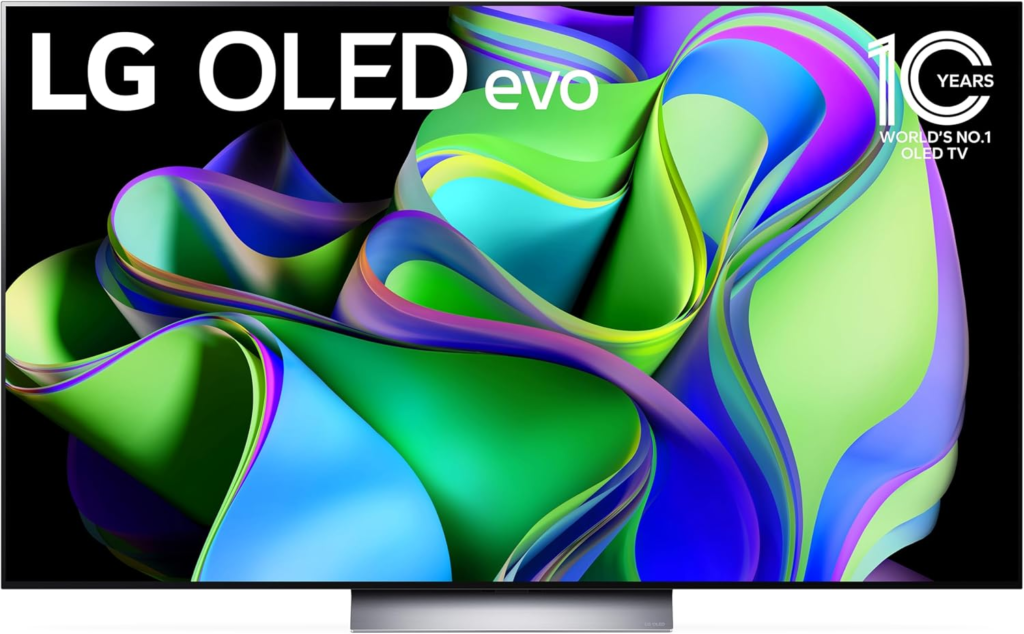
- Sizes: 42″, 48″, 55″, 65″, 77″, 83″
- Panel: OLED Evo
- Latest Update: 2025 model features brighter OLED panel and enhanced gaming features. Visit LG’s C3 page.
Design
The C3 Evo is sleek, with razor-thin bezels and a low-profile stand. Its lightweight build (thanks to OLED’s lack of backlight) makes wall-mounting a cinch. The 42″ and 48″ sizes are rare OLED treats for smaller spaces. The 2025 model introduces a zero-gap wall mount for a flush fit.
Picture Quality
OLED shines here: perfect blacks, infinite contrast, and wide viewing angles make every frame pop. The Evo panel ups brightness to 900 nits in the 2025 model, tackling OLED’s traditional weakness. HDR (Dolby Vision, HDR10, HLG) is breathtaking—think inky shadows in The Batman paired with dazzling highlights. Motion handling is smooth, and upscaling is top-tier.
Sound Quality
The 40W 2.2-channel speakers deliver crisp dialogue and subtle bass, enhanced by Dolby Atmos. It’s above average for a TV, though a soundbar elevates the experience. The 2025 model adds AI Sound Pro for virtual 7.1.2 surround.
Smart Features
webOS is a joy—intuitive, customizable, and packed with apps. Voice control via Alexa or Google Assistant is seamless, and AirPlay 2 adds iOS compatibility. The Magic Remote’s pointer simplifies navigation. The 2025 update includes webOS 7.0 with improved app organization.
Connectivity
Four HDMI 2.1 ports unlock 4K/120Hz, VRR, and ALLM—gamer heaven. USB, Ethernet, and Wi-Fi 6 round it out. The 2025 model adds an extra USB-C port for faster data transfer.
Key Features
- OLED Evo panel with 900 nits brightness
- 120Hz refresh rate with VRR
- Dolby Vision IQ and HDR10 Pro
- webOS 7.0 with AI ThinQ
- G-Sync and FreeSync Premium
- Ultra-slim design with zero-gap mount
Pros
- Unmatched contrast and perfect blacks
- Exceptional gaming performance (1ms response)
- Wide viewing angles for group viewing
- Brightest OLED yet at 900 nits
- Elegant, ultra-slim design
- Robust smart platform with webOS 7.0
Cons
- Risk of burn-in with static content
- Pricier than QLED alternatives
- Brightness still lower than top QLEDs
- No support for HDR10+
- Complex settings menu for novices
- Stand design may not suit all surfaces
Verdict
The LG C3 Evo is a mid-range marvel, offering OLED’s magic to movie buffs and gamers without the flagship price tag.
Samsung S90C: QLED Brilliance
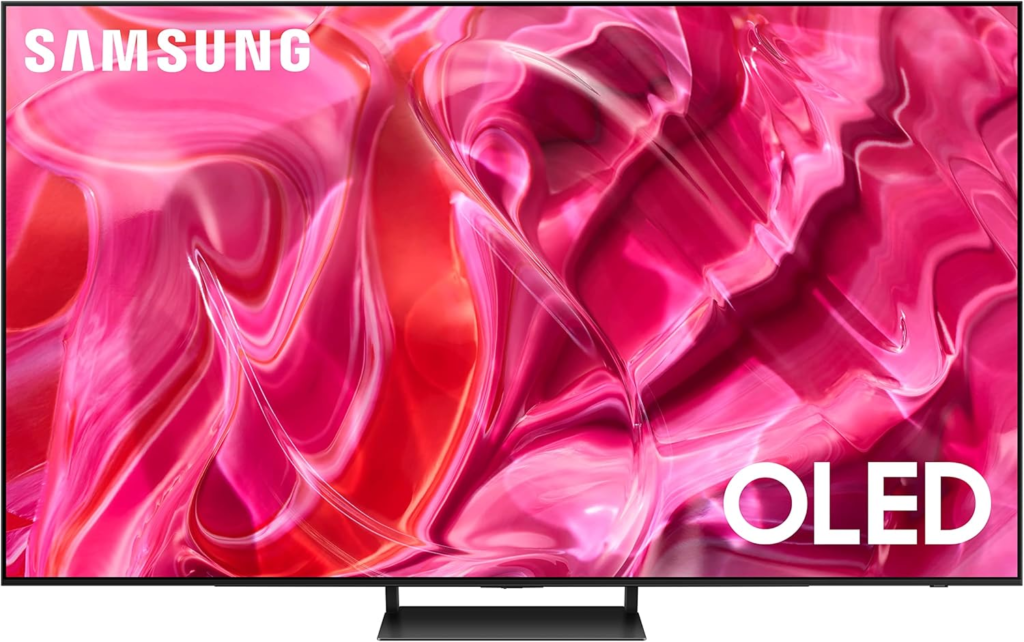
- Sizes: 55″, 65″, 77″, 83″
- Panel: QLED with Quantum HDR
- Latest Update: 2025 model introduces improved local dimming and eco-friendly features. See Samsung’s S90C page.
Design
The S90C’s “LaserSlim” design is stunning—near-borderless with a slim profile and central stand. It’s a living room centerpiece. The 2025 model features recyclable packaging and a solar-powered remote.
Picture Quality
QLED’s forte is brightness (up to 1200 nits in 2025), and the S90C delivers. Colors are punchy, and HDR10+ enhances dynamic scenes. Local dimming improves contrast, though blacks aren’t OLED-deep. Viewing angles are narrower, so center seating is best. The 2025 update includes Quantum Matrix Technology for finer dimming control.
Sound Quality
The 40W 2.1 speakers offer decent clarity and bass, with Object Tracking Sound for directional audio. Atmos support is included, but external audio shines brighter. The 2025 model adds Adaptive Sound+ for room-optimized audio.
Smart Features
Tizen is fast and polished, with Samsung’s app suite and voice control (Bixby, Alexa, Google Assistant). The SolarCell Remote charges via light—no batteries needed. The 2025 update includes Multi-View for simultaneous content streaming.
Connectivity
Four HDMI ports (two 2.1) handle 4K/120Hz gaming, plus USB and Wi-Fi 6. The 2025 model adds an extra HDMI 2.1 port for more gaming flexibility.
Key Features
- QLED panel with 1200 nits brightness
- Quantum HDR with HDR10+
- 120Hz refresh rate with Motion Xcelerator Turbo+
- Tizen OS with Multi-View
- SolarCell Remote with eco-design
- Slim Fit Wall Mount compatible
Pros
- Vibrant, bright visuals for any room
- Excellent for gaming with low input lag
- Sleek, innovative design
- Eco-friendly features and packaging
- Strong smart platform with Tizen
- Improved local dimming in 2025
Cons
- Limited viewing angles
- No Dolby Vision support
- Blacks not as deep as OLED
- Sound lacks depth without a soundbar
- Higher power consumption
- Premium pricing for larger sizes
Verdict
The Samsung S90C balances brightness and style, making it a top mid-range pick for bright rooms and casual gamers.
LG Evo G4: The OLED Elite
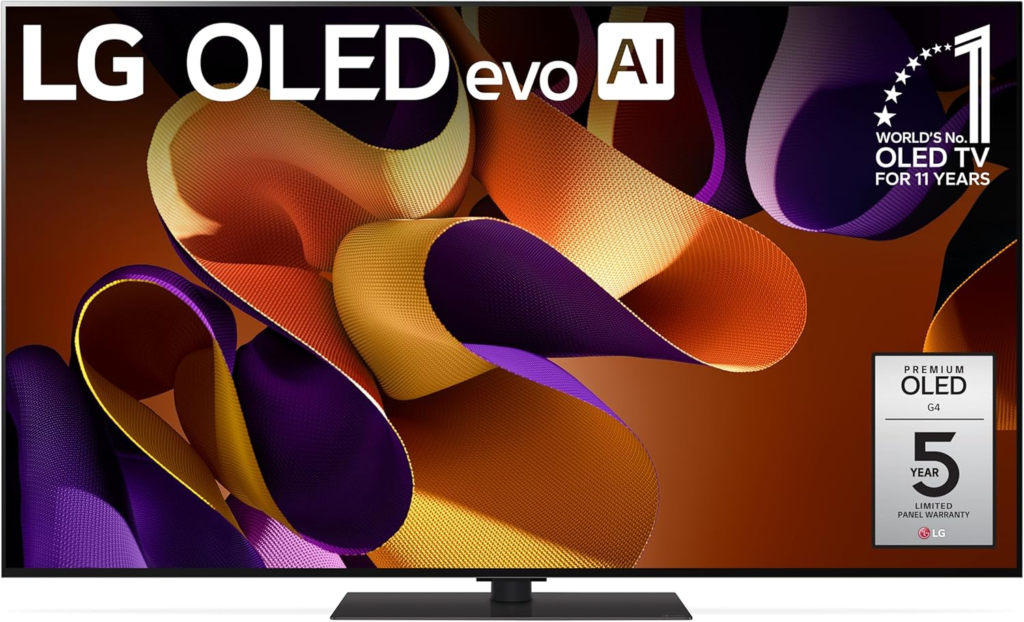
- Sizes: 55″, 65″, 77″
- Panel: OLED Evo with Micro Lens Array (MLA)
- Latest Update: 2025 model features MLA 2.0 for even higher brightness and efficiency. Visit LG’s G4 page.
Design
The G4’s gallery aesthetic—ultra-thin with a flush wall-mount option—screams luxury. The stand is sturdy yet unobtrusive. The 2025 model introduces a wireless option for a cleaner look.
Picture Quality
The G4 pushes OLED to new heights with MLA 2.0, hitting 1800 nits. Blacks are flawless, colors are precise, and HDR (Dolby Vision, HDR10) is reference-grade. Motion is buttery, and upscaling rivals professional remasters. The 2025 update includes AI Picture Pro for enhanced detail in dark scenes.
Sound Quality
A 60W 4.2-channel system with Atmos delivers cinematic sound—deep bass and spatial effects impress. Still, audiophiles may want more. The 2025 model adds wireless Dolby Atmos for compatible soundbars.
Smart Features
webOS evolves with AI personalization and a slicker UI. Voice control and AirPlay 2 are flawless. The 2025 update includes webOS 8.0 with integrated NFT marketplace for digital art display.
Connectivity
Four HDMI 2.1 ports, Wi-Fi 6, and eARC keep it future-ready. The 2025 model adds Wi-Fi 6E for faster streaming.
Key Features
- OLED Evo with MLA 2.0 (1800 nits)
- 120Hz with VRR and G-Sync
- Dolby Vision IQ and HDR10 Pro
- webOS 8.0 with AI ThinQ
- Wireless Dolby Atmos support
- Gallery design with wireless option
Pros
- Best-in-class picture quality
- Exceptional brightness for OLED
- Premium, luxurious design
- Top-tier gaming performance
- Rich, immersive audio
- Future-proof with Wi-Fi 6E
Cons
- Very high cost
- Burn-in risk remains
- Limited size options
- Complex calibration for pros
- Wireless setup requires compatible devices
- Stand may not suit all setups
Verdict
The LG Evo G4 is the ultimate TV for those who demand perfection in visuals and features.
Samsung S95D: QLED’s Crown Jewel
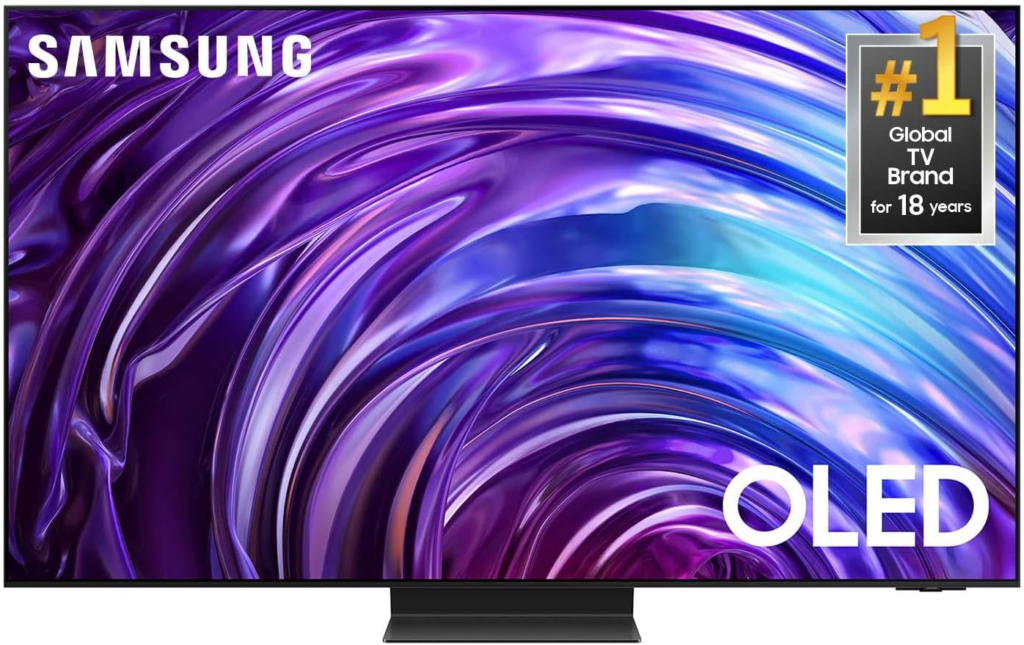
- Sizes: 55″, 65″, 75″, 85″
- Panel: QLED with Quantum HDR OLED+
- Latest Update: 2025 model introduces QD-OLED hybrid technology for improved color and contrast. See Samsung’s S95D page.
Design
The S95D’s One Connect Box hides cables, paired with a sleek stand and minimal bezels. It’s a tech showcase. The 2025 model features a slimmer One Connect Box and a new anti-glare coating.
Picture Quality
Brightness soars to 2500 nits, and advanced dimming rivals OLED contrast. Colors are dazzling, and HDR10+ shines. The QD-OLED hybrid panel in the 2025 model delivers perfect blacks and wide viewing angles, a first for QLED.
Sound Quality
70W 4.2.2-channel speakers with Atmos track action across the screen. It’s immersive, though a soundbar can refine it. The 2025 model adds Object Tracking Sound Pro for even more precise audio placement.
Smart Features
Tizen’s AI enhancements and ambient mode turn the TV into art. Voice control is robust. The 2025 update includes Tizen 7.0 with integrated gaming hub for cloud gaming services.
Connectivity
Four HDMI 2.1 ports, Wi-Fi 6, and a slim One Connect Box. The 2025 model adds an extra HDMI 2.1 port and USB-C for faster data transfer.
Key Features
- QD-OLED hybrid panel (2500 nits)
- Quantum HDR OLED+ with HDR10+
- 144Hz refresh rate for gaming
- Tizen 7.0 with Gaming Hub
- One Connect Box with slim design
- Anti-glare and anti-reflection coating
Pros
- Blinding brightness with deep blacks
- Wide viewing angles with QD-OLED
- Exceptional for gaming (144Hz)
- Premium build and design
- Immersive audio with OTS Pro
- Future-proof with extra HDMI 2.1
Cons
- No Dolby Vision support
- Very expensive
- Large sizes may not fit all spaces
- Complex setup with One Connect Box
- Higher power consumption
- Limited to Samsung’s ecosystem
Verdict
The Samsung S95D is a QLED titan, perfect for bright spaces and high-end setups, now with OLED-like contrast.
New Additions for 2025
Sony Bravia 9: Mini-LED Marvel
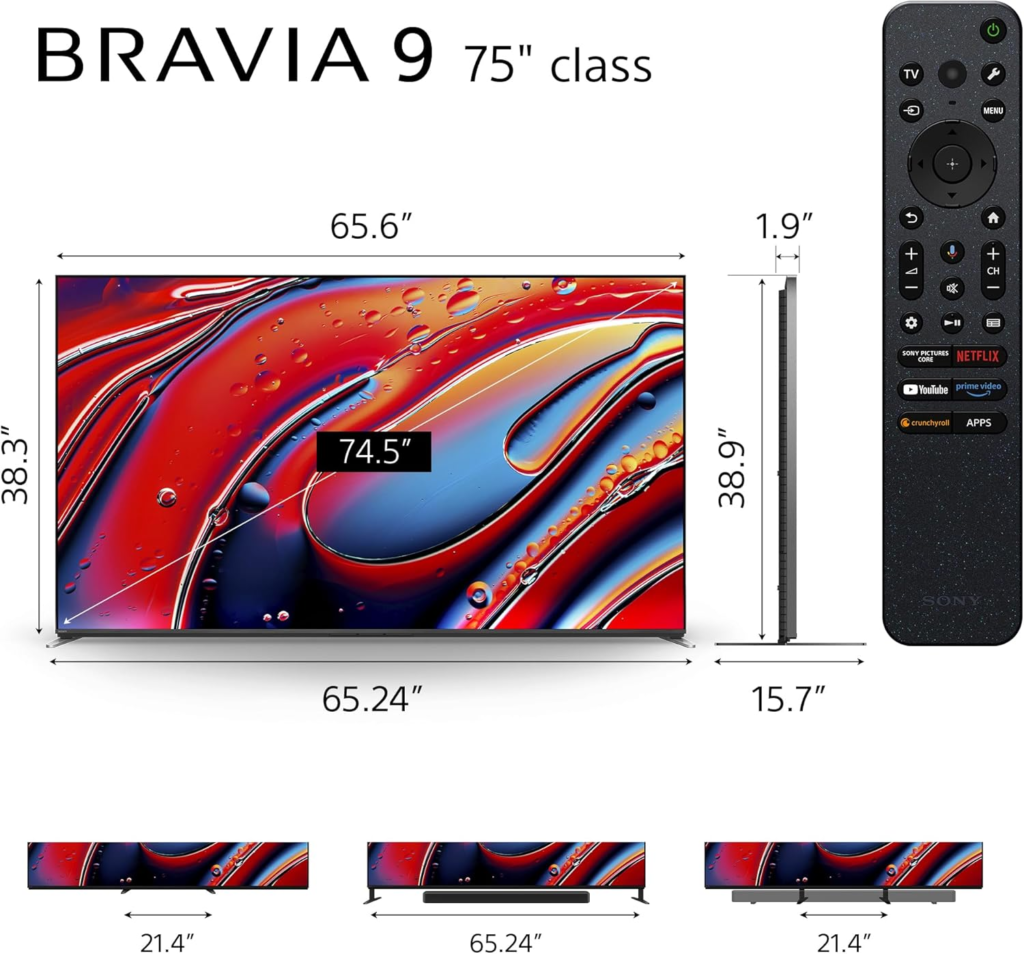
- Sizes: 55″, 65″, 75″, 85″
- Panel: Mini-LED with XR Backlight Master Drive
- Latest Update: 2025 model introduces Cognitive Processor XR 2.0 for enhanced AI upscaling. Visit Sony’s Bravia 9 page.
Design
The Bravia 9 features a sleek, minimalist design with ultra-thin bezels and a sturdy stand. The 2025 model includes a new Acoustic Surface Audio+ system for improved sound.
Picture Quality
Mini-LED technology delivers exceptional brightness (up to 2000 nits) and contrast, with thousands of dimming zones. The Cognitive Processor XR 2.0 enhances upscaling and motion handling, making even low-resolution content look stunning.
Sound Quality
The Acoustic Surface Audio+ system uses the screen as a speaker, providing clear dialogue and immersive sound. The 2025 model adds Dolby Atmos support for a more cinematic experience.
Smart Features
Android TV offers a vast app library and Google Assistant integration. The 2025 update includes a new user interface for easier navigation.
Connectivity
Four HDMI 2.1 ports, Wi-Fi 6, and eARC. The 2025 model adds an extra USB port for more device connections.
Key Features
- Mini-LED with XR Backlight Master Drive
- Cognitive Processor XR 2.0
- Acoustic Surface Audio+ with Dolby Atmos
- Android TV with Google Assistant
- Bravia Core streaming service
- Exclusive PS5 features
Pros
- Exceptional brightness and contrast
- Advanced AI upscaling
- Immersive sound from screen
- Robust smart platform
- Gaming optimized for PS5
- Wide range of sizes
Cons
- Higher cost than some rivals
- Bulkier than OLED models
- Limited to 60Hz on some sizes
- Complex remote control
- Occasional blooming in dark scenes
- Android TV can be sluggish
Verdict
The Sony Bravia 9 is a mini-LED masterpiece, offering stunning visuals and sound for movie lovers and gamers alike.
TCL C855: Affordable 8K Option
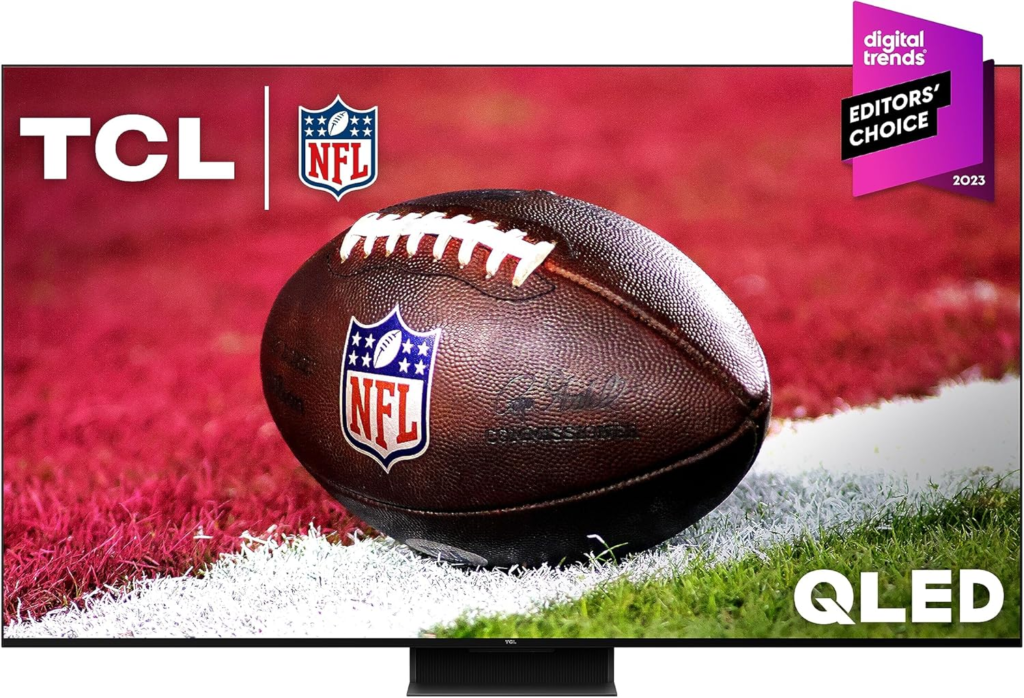
- Sizes: 65″, 75″, 85″
- Panel: 8K QLED with Mini-LED
- Latest Update: 2025 model introduces 8K AI upscaling and improved color accuracy. See TCL’s C855 page.
Design
The C855 features a modern design with slim bezels and a central stand. The 2025 model includes a new cable management system for a cleaner look.
Picture Quality
8K resolution provides incredible detail, and the mini-LED backlight offers excellent contrast and brightness (up to 1500 nits). The 2025 update includes 8K AI upscaling, making 4K content look nearly native 8K.
Sound Quality
The 30W speakers are decent, with clear dialogue and moderate bass. The 2025 model adds Dolby Atmos support for a more immersive audio experience.
Smart Features
Roku TV offers a user-friendly interface and a vast app selection. The 2025 update includes voice control via Roku Voice Remote.
Connectivity
Four HDMI 2.1 ports, Wi-Fi 6, and eARC. The 2025 model adds an extra HDMI port for more device connections.
Key Features
- 8K QLED with mini-LED backlight
- 8K AI upscaling
- Roku TV with voice control
- Dolby Vision and HDR10+
- 120Hz refresh rate
- Affordable for 8K
Pros
- Affordable entry to 8K
- Excellent upscaling capabilities
- Bright and vibrant colors
- User-friendly Roku platform
- Good for gaming with 120Hz
- Multiple HDR formats supported
Cons
- Limited native 8K content
- Sound quality is average
- Bulkier than some competitors
- Upscaling can be hit or miss
- Limited size options
- Roku ads can be intrusive
Verdict
The TCL C855 is a budget-friendly 8K TV that offers impressive performance and features for the price.
Sharp Aquos XLED: Hybrid Display Innovation
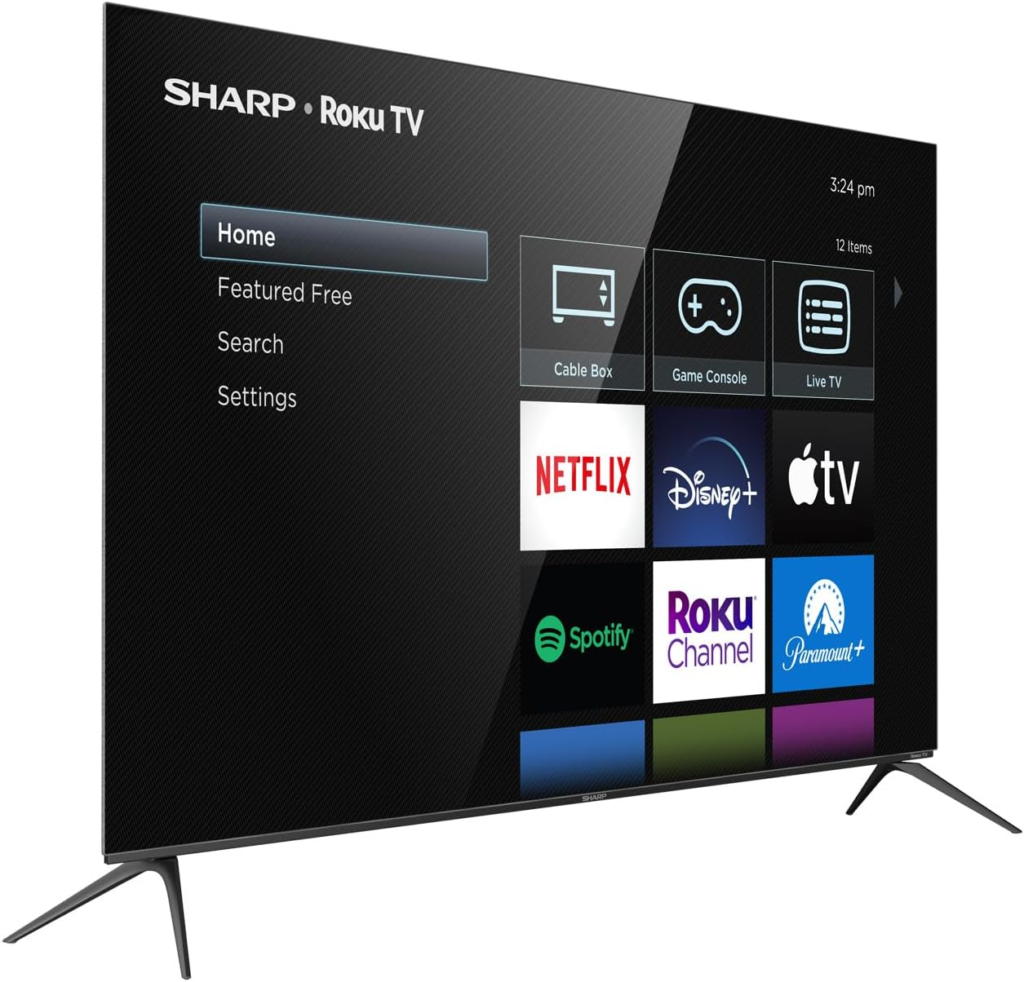
- Sizes: 55″, 65″, 75″
- Panel: XLED (Mini-LED + Quantum Dot)
- Latest Update: 2025 model introduces XLED technology for improved color and contrast. Visit Sharp’s Aquos page.
Design
The Aquos XLED features a sleek design with thin bezels and a central stand. The 2025 model includes a new ambient light sensor for automatic brightness adjustment.
Picture Quality
XLED technology combines mini-LED backlighting with quantum dots for exceptional brightness (up to 1800 nits) and color accuracy. The 2025 update includes improved local dimming for better contrast.
Sound Quality
The 30W speakers provide clear dialogue and moderate bass. The 2025 model adds Dolby Atmos support for a more immersive audio experience.
Smart Features
Android TV offers a wide range of apps and Google Assistant integration. The 2025 update includes a new user interface for easier navigation.
Connectivity
Four HDMI 2.1 ports, Wi-Fi 6, and eARC. The 2025 model adds an extra USB port for more device connections.
Key Features
- XLED panel with mini-LED and quantum dots
- 120Hz refresh rate with VRR
- Android TV with Google Assistant
- Dolby Vision and HDR10+
- Ambient light sensor
- Good for gaming
Pros
- Exceptional brightness and color
- Good contrast with mini-LED
- Robust smart platform
- Gaming optimized with VRR
- Multiple HDR formats supported
- Automatic brightness adjustment
Cons
- Higher cost than some competitors
- Limited size options
- Sound quality is average
- Android TV can be slow
- Complex settings menu
- New technology may have teething issues
Verdict
The Sharp Aquos XLED is an innovative TV that offers impressive performance with its hybrid display technology.
Top FAQs Answered
Here are answers to the most commonly asked questions about TVs in 2025, based on consumer trends and expert insights:
What’s the difference between 60Hz and 120Hz refresh rates?
A 60Hz TV refreshes the image 60 times per second, which is fine for most movies and TV shows filmed at 24 or 30 frames per second. A 120Hz TV doubles that to 120 refreshes per second, reducing motion blur in fast-paced content like sports, action movies, or gaming. For gamers, 120Hz paired with HDMI 2.1 and VRR (like on the LG C3 Evo) ensures smoother gameplay at higher frame rates. Learn more at RTINGS.com’s refresh rate guide.
Do I need a soundbar with my TV?
While modern TVs like the LG Evo G4 (with 60W Atmos speakers) or Philips OLED+908 (with a Bowers & Wilkins soundbar) offer decent built-in audio, most—especially budget models like the Hisense U6N—fall short on bass and immersion. A soundbar, especially one with Dolby Atmos support, dramatically enhances dialogue clarity and surround sound. Experts at What Hi-Fi recommend it for a cinematic experience.
Can burn-in still happen with OLED TVs in 2025?
Yes, though it’s less common. OLEDs like the LG C3 Evo and G4 use self-emissive pixels, which can retain static images (e.g., news tickers) over time. However, 2025 models feature advanced mitigation like pixel shifting and screen savers. Burn-in is rare with varied content and normal use—check CNET’s burn-in test for real-world data. QLEDs like the Samsung S95D avoid this entirely.
How many HDMI ports do I really need?
It depends on your setup. A single console and streaming stick need two ports, but add a soundbar (via eARC), Blu-ray player, or second console, and four ports—like on the Sony Bravia 9 or TCL C855—are ideal. HDMI 2.1 ports (supporting 4K/120Hz) are crucial for next-gen gaming. TechRadar’s HDMI guide explains port standards.
Are smart TVs worth it over a streaming device?
Smart TVs (e.g., Samsung S90C with Tizen) offer convenience with built-in apps and voice control, but dedicated devices like the Roku Ultra or Apple TV 4K often provide faster performance and broader app support. If your TV’s platform (like Vizio’s SmartCast) lacks apps or feels sluggish, a streaming stick is a cheap upgrade. See PCMag’s comparison.
What’s the best TV size for a small room?
For a room with a 5-7 foot viewing distance, a 43-55 inch TV strikes the balance between immersion and comfort. The LG C3 Evo’s 42″ option or Vizio Quantum X’s 50″ size are great picks. Larger sets (65″+) can strain your eyes or distort the picture up close. Use RTINGS’ size calculator to confirm.
How long will a 2025 TV last?
Premium TVs from LG, Samsung, and Sony typically last 7-10 years with normal use (5-6 hours daily), thanks to durable panels and software updates. OLEDs may dim slightly over time, while QLEDs and Mini-LEDs maintain brightness longer. Budget models like the Hisense U6N might show wear sooner. Consumer Reports estimates lifespans based on testing.
FAQs: Your Questions Answered
Q: OLED vs. QLED—Which is better?
A: OLED wins on contrast and viewing angles; QLED excels in brightness and durability. Choose based on room lighting and content. PCMag breaks it down.
Q: Is 8K worth it in 2025?
A: Not yet for most—4K content dominates, and upscaling varies in quality. Go 8K for huge screens or future-proofing.
Q: Best TV for gaming?
A: LG C3 Evo or G4—120Hz, low lag, and HDMI 2.1 make them unbeatable.
Q: How do I improve TV sound?
A: Pair with a Dolby Atmos soundbar via eARC for room-filling audio.
Q: What’s the ideal calibration approach?
A: Use built-in picture modes (e.g., Filmmaker) or a calibration disc like Spears & Munsil.
Comparison Table
| TV Model | Sizes | Panel | Resolution | HDR | Refresh Rate | Smart Platform | HDMI Ports | Price Range |
|---|---|---|---|---|---|---|---|---|
| Hisense U6N | 50″-85″ | QLED | 4K | HDR10, DV | 60Hz | Google TV | 4 (2 HDMI 2.1) | $500-$1,500 |
| LG C3 Evo | 42″-83″ | OLED | 4K | HDR10, DV, HLG | 120Hz | webOS | 4 HDMI 2.1 | $1,000-$4,000 |
| Samsung S90C | 55″-83″ | QLED | 4K | HDR10+ | 120Hz | Tizen | 4 (2 HDMI 2.1) | $1,200-$3,500 |
| LG Evo G4 | 55″-77″ | OLED | 4K | HDR10, DV, HLG | 120Hz | webOS | 4 HDMI 2.1 | $2,000-$5,000 |
| Samsung S95D | 55″-85″ | QD-OLED | 4K | HDR10+ | 144Hz | Tizen | 4 HDMI 2.1 | $2,500-$6,000 |
| Sony Bravia 9 | 55″-85″ | Mini-LED | 4K | HDR10, DV | 120Hz | Android TV | 4 HDMI 2.1 | $1,800-$4,500 |
| TCL C855 | 65″-85″ | 8K QLED | 8K | HDR10, DV, HLG | 120Hz | Roku TV | 4 HDMI 2.1 | $1,500-$3,000 |
| Philips OLED+908 | 55″-77″ | OLED | 4K | HDR10, DV, HLG | 120Hz | Android TV | 4 HDMI 2.1 | $2,000-$4,500 |
| Vizio Quantum X | 50″-75″ | QLED | 4K | HDR10, DV | 120Hz | SmartCast | 4 HDMI 2.1 | $800-$2,000 |
| Sharp Aquos XLED | 55″-75″ | XLED | 4K | HDR10, DV | 120Hz | Android TV | 4 HDMI 2.1 | $1,500-$3,500 |
Final Thoughts
The best TV for 2025 depends on your needs. The Hisense U6N offers unbeatable value, the LG C3 Evo and Samsung S90C strike a mid-range balance, and the LG Evo G4 and Samsung S95D redefine premium. With new additions like the Sony Bravia 9 and TCL C855, there’s a perfect TV for every budget and preference. Dive into our reviews, weigh your priorities, and elevate your entertainment game today!


